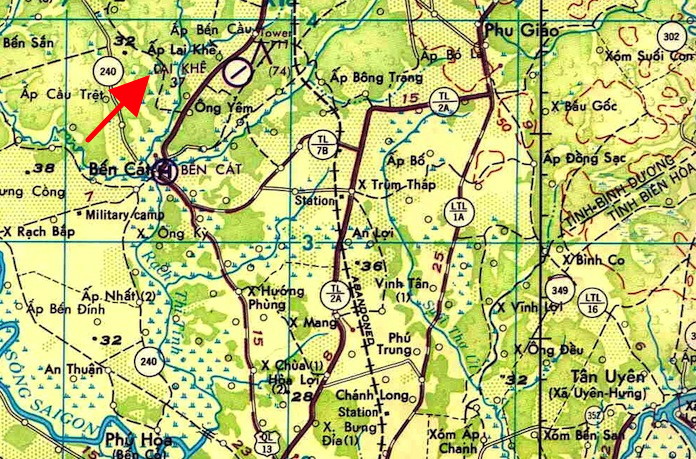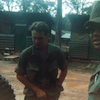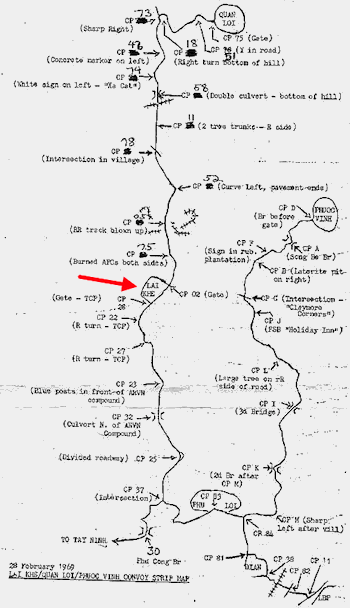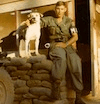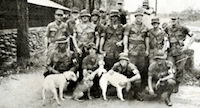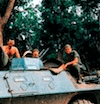Passing through Lai Khe, Highway QL-13, also known in later years by the U.S. units that traveled it as "Thunder Road," was the main artery for supplies going northwest to An Loc in the Parrots Beak area of III Corps Tactical Zone near the Cambodian border and enemy sanctuaries.
Keeping the highway open was vital to the numerous fire support bases of the Saigon Defensive Ring. In July of 1966 Elements of the 1st Infantry Division began clearing operations along Highway QL-13 to protect its supply convoys from further enemy attacks.
From October 1967 through October 1969 the Headquarters of the 1st Infantry Division moved to the base camp from Di An.
From 22 April through 11 May battalion elements were temporarily stationed at the base camp while supporting Operation MANHATTAN.
Tet New Years Communist Offensive |
Between 31 January and 3 February Lai Khe received forty-two attacks by fire, including 141 rounds of 122mm rocket fire.
Between 14 March and 13 April Lai Khe Base was subject to twenty-six separate North Vietnamese Army 122mm rocket attacks.
In the fall of the year the 1st Cavalry Division (Airmobile) moved into III Corps Tactical Zone. Elements of the division were sent to the base camps of Quan Loi and Lai Khe.
On 8 October 1968 under orders from Battalion S3 (Operations), Charlie Company transferred 1LT Herbert R. "Herb" Bradley, III and a platoon of thirty enlisted men from their 1st Infantry Division base camp detachment at Phu Loi to the base camp at Di An.
They were attached to the Provost Marshal, 1st Infantry Division and aided the 1st MP Company in the mission of combat support by staffing a Traffic Control Point (TCP) and providing escorts for two daily convoys to Lai Khe utilizing two gun jeeps and six MP's for each run. The code name for the 1st Infantry Division convoys to Lai Khe was "Iron".
The 1st Infantry Division's other convoy to Quan Loi was called the "Devils Convoy" and the run to Phuoc was called "Lead".
The C Company convoy escorts to Lai Khe continued. The North Vietnamese Army operating in the area became so active in ambushing the convoys that the C Company escorts began using the V100 Armored Commando Cars supported by 1st Infantry Division armored elements.
Intensified Vietnamization Program |
The ARVN 5th Infantry Division officially took over control of the area of operations of the U.S. 1st Infantry and 1st Air Cavalry Divisions including the base at Lai Khe.
With the stand-down of U.S. combat arms units in Military Region III, the 1st and 25th MP Company's were returned stateside with their divisions leaving a void. The Battalion was tasked with filling it. C Company personnel that were working the Lai Khe convoy escorts from Long Binh Post were reassigned to the new detachment.
SSG Robert Schuyler was the NCOIC and 1LT Charles Smith was assigned as the first Officer In Charge (OIC) and acting Provost Marshal for Lai Khe and all area detachments.
When the C Company staff first arrived at the base routine comforts were sparse. They had no bathing facilities and washed with a hose until they could build a shower room.
Reflections-1 SGT Steven D. Patrick, C Company, 720th MP Battalion, December 1969 to February 1971.
On 7 April 1LT Frederick A. Gertz of C Company was assigned as the new OIC and Provost Marshal at Lai Khe until his departure on19 July.
Reflections-2 SGT Steven D. Patrick, C Company, 720th MP Battalion, December 1969 to February 1971.
|






